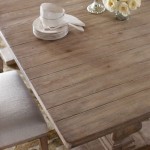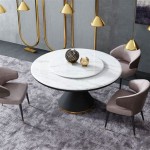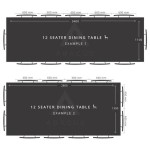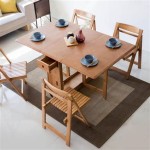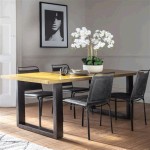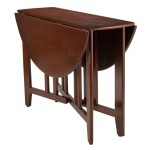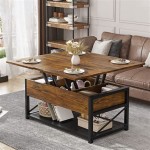Chalk Paint: A Versatile Option for Your Dining Room Table
When it comes to transforming your dining room table, chalk paint offers a unique and versatile approach. Its ease of use, ability to adhere to various surfaces, and ability to create a variety of finishes make it a popular choice among DIY enthusiasts and seasoned furniture refinishers alike. This article will delve into the key aspects of using chalk paint on dining room tables, providing a comprehensive guide for anyone considering this approach.
Understanding Chalk Paint
Chalk paint, as its name suggests, has a chalky texture and a matte finish. It is typically water-based and contains a high concentration of pigments, giving it excellent coverage and a rich color payoff. One of its key advantages is its ability to adhere directly to most surfaces without the need for sanding or priming. This quality makes it ideal for refinishing furniture that may have been painted previously or have a textured surface.
Chalk paint is also known for its ability to create a distressed or antique look. This is achieved through techniques like layering colors, sanding, and applying wax. The paint's matte finish allows for a subtle patina to develop with time, adding to its charm and character. While chalk paint excels in creating distressed looks, it can also be used to achieve a smooth, modern finish with the proper techniques.
The Benefits of Using Chalk Paint on a Dining Room Table
Chalk paint offers a range of benefits for transforming a dining room table. It can create a dramatic visual change, enhance the overall style of the room, and increase the table's longevity. Here are some of the key benefits:
Easy Application and Adhesion
Chalk paint is known for its ease of application. It can be applied directly to most surfaces, including wood, metal, plastic, and even glass. The paint's thick consistency allows for a smooth, even coat with minimal brush strokes. This makes it an excellent choice for beginners who may not have extensive experience with painting furniture.
Versatile Finishes
Chalk paint can be used to achieve a variety of finishes, from a smooth, modern look to a heavily distressed antique finish. The paint's matte finish readily accepts waxes, glazes, and stains, allowing for further customization. You can easily create a one-of-a-kind look for your table that complements your dining room's decor.
Cost-Effective and Durable
Using chalk paint on your dining room table can often be a cost-effective solution compared to hiring a professional refinisher or purchasing a new table altogether. The paint is readily available at a variety of retailers and DIY stores. Furthermore, chalk paint is known for its durability, making it an excellent choice for high-traffic furniture like dining tables.
Preparing Your Dining Room Table for Chalk Paint
Proper preparation is key to achieving a successful and long-lasting finish when using chalk paint on your dining room table. Here are the essential steps to ensure your table is ready for its transformation:
Cleaning the Surface
Start by thoroughly cleaning the table with a mild detergent and water. This removes dirt, grease, and any residues that may hinder the paint's adhesion. Allow the table to dry completely before proceeding to the next step.
Sanding (Optional)
While chalk paint can adhere to most surfaces without sanding, it is generally recommended to lightly sand the table's surface. Sanding helps to create a better surface for the paint to adhere to and can help to even out any imperfections. Use a fine-grit sandpaper and lightly sand the entire surface, focusing on areas with rough spots or old finishes.
Priming (Optional)
Priming is not always necessary, but it can be beneficial in certain cases, particularly when using chalk paint on a very porous surface, such as raw wood. Priming creates a smooth and even surface for the paint to adhere to, preventing uneven coverage and bleeding through. A primer specifically designed for use with chalk paint is recommended.
Applying Chalk Paint
Once the table is prepared, you can begin applying the chalk paint. Use a high-quality paintbrush or a foam roller, applying thin, even coats. Allow each coat to dry completely before applying the next. The number of coats needed will depend on the desired opacity and the color of the paint.
Finishing Touches
After the paint is dry, you can add finishing touches to enhance the look of your dining room table. Consider the following options:
Distressing
If you want a distressed look, you can use fine-grit sandpaper to gently sand away some of the paint, revealing the underlying wood or previous layers of paint. This technique adds a vintage or antique feel to the table.
Waxing
Waxing provides a protective layer over the chalk paint, enhancing its durability and creating a smooth, satin finish. Apply a clear or tinted wax with a clean cloth and buff it into the paint according to the manufacturer's instructions.
Glazing
Glazing adds depth and dimension to the paint, creating a subtle, layered effect. Apply a glaze with a brush or sponge, blending it into the paint for a smooth, even finish.
Transforming your dining room table with chalk paint can be a rewarding and enjoyable experience. With proper preparation, meticulous application, and creative finishing touches, you can create a stunning centerpiece for your dining area.

How To Save Tired Dining Room Chairs With Chalk Paint Right Now

Antique Dining Table Updated With Chalk Paint Anderson Grant

Chalk Paint Dining Set Makeover

Diy Chalk Painted Dining Table Zevy Joy

Antique Dining Table Updated With Chalk Paint Anderson Grant

How To Update A Table With Chalk Paint I Dig Pinterest

Painting A Dining Room Set With Chalk Paint The Purple Painted Lady

How To Chalk Paint A Table And Chairs Confessions Of Serial Do It Yourselfer

Dining Room Chair In Annie Sloan Chalk Paint Duck Egg And Cushion P Kaufmann Brissac Jewel

How To Save Tired Dining Room Chairs With Chalk Paint Right Now

